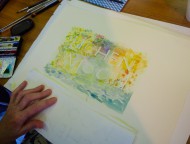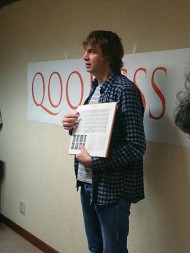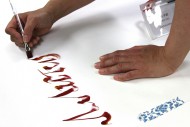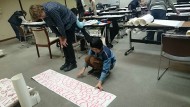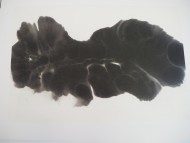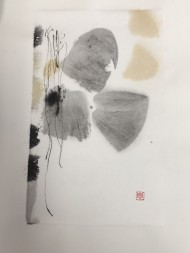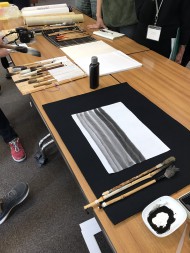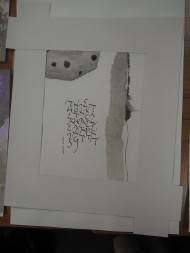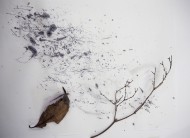‘The Painted Letter’ by EWAN CLAYTON
Philippa Black (UK) with Celia Almeida(UAE)
For Ewan’s class, “The Painted Letter”, we started by writing the alphabet with a large calligraphy nib using upper case letters which we then traced with a hard pencil. We wrote words by outlining the letters with a fine brush line and filling in with sumi ink. The words we chose to write were related to our surroundings, such as moss, pine and leaf.
Ewan had brought with him many examples of the London lettering artist, Mike Pratley. We focused on his very varied use of serifs and learnt how to paint a straight edged letter with a western paintbrush. Also a curved letter by rolling the hairs of the brush into the inside of the stroke. We drew and painted a pointed serif, a wedged serif, a splayed serif and a slab serif.
We also studied the work of Michael Harvey a British type designer, lettering artist and stone cutter. He developed a technique of sketching the letter which he then built up with further sketched lines, giving the letter body. We learnt this technique. We also learnt how to do a lower case italic by building it from the centre of each stroke and dragging it out with a brush to make “spooky” writing.
We looked at Sue Hufton’s painted letters which she paints onto a variety of materials, including fabric which she also embroiders with fine stitching. We studied her painted versals and did some of our own.
And we learnt about the painter and poet David Jones who painted inscriptions creating his own form of capitals from early Roman letters whilst using them in an evocative way. As did another artist, Ben Shahn, who also used letters to create pictures that reflected his social concerns.
We saw how these artists used the structures of letters to lead the eye to focal points, how the shape and style of the serif can direct the eye inwards or outwards or in a flowing way, sometimes taking the eye to an important word or space. This showed the significant difference between an artistic approach to calligraphy as opposed to the typographer’s. The calligrapher can add meaning and atmosphere to the text through colour and sometimes extreme shaping of serifs and letters whereas the typographer can make subtle adjustments but not be as excessive.
Ewan opened doors for us into diverse lettering worlds. His objective was to inspire us to experiment whilst giving us practical tips on how to use a western brush, how to shape letters and draw. He also gave us physical exercise tips on how to keep warm in a beautiful but chilly space!
‘On the Edge of the Brush’ by TOM KEMP
Joy Deneen (Canada)
I never suspected that my deepest dive into the world of Trajan letters would take place in the foothills of Kyoto, with classmates from all around the globe. Led by Tom Kemp, our class went on a journey that far exceeded expectations. Tom is known for his expressive mastery of the brush, using the tool to create dynamic strokes on his ceramic vessels. Tom shared how many Western calligraphers wish to hold the brush like a pen, but the possibilities are far greater. Unlike the pen, one can choose any angle and any direction with the brush, which increases the possibilities for our writing. However, he explained to us that, in order to learn how to use a historical tool, you must learn it through studying a historical script. To study the brush in a Western context, we must go back to the Trajan column. An impressive monument commemorating the emperor’s victories, this column has stood since the year 113. It includes a beautiful inscription that is nearly complete and has 19 out of the 26 Roman letters represented.
We rolled out paper along the full length of our tables and prepared a palette of coloured gouache. Expertly guided by Tom and the spirit of Father Catich, we began our intensive study with the simple and straight “I” and “E” and progressed to more complex and curved shapes like “C” and “S”. Tom deconstructed each letter on the white board, showing us the ductus and geometry in detail. He then moved to a wall, to show us how to construct the letter with the brush. We watched rapt, holding our breath as he moved his brush with confidence and grace. Moving back to our own paper, it was a real challenge to achieve fluid strokes and proper proportions, but we were focused and determined. While the subject was very difficult, Tom’s down-to-earth nature fostered a warm and open atmosphere in the classroom.
After an intensive two and a half days of analyzing the traditional letterforms, Tom asked us to consider our own journey with Trajans. Did we want to perfect our spacing and work on those elegant ox bow serifs? Were we interested in developing numerals or inventing the non-Latin letters (H, J, K, U, W, Y and Z)? Or perhaps we were inspired to explore the possibilities beyond the traditional forms. As a group, we brainstormed a list of ideas for variations. What if we changed the slant? What if we experimented with different ratios of letter height to brush width? What might happen if we increased the ratio to 12 or even 50 brush width? What if we changed the stress or twisted our brush in new ways? Tom pointed out that with extreme changes, the forms would no longer be Trajan, but ultimately, he wanted to see us to explore the many possibilities of the brush. “The more you can accept the terror of the blank page and a brush full of paint, the better.
The class became a scriptorium of sorts, with Tom guiding our individual studies. Some students chose to design their own organic alphabet, while others selected a variation from our brainstorm. We were encouraged take our own individual journey, choosing one specific possibility to explore for the remainder of the symposium. Tom stressed that the real exercise was not the final form but process. He asked us to think about feeling - “what are you aiming for in a sensual way?” We had a full day of experimentation, followed by time to consolidate our ideas and refine the details. At the end of the course, we spent several hours making our final inscription, to record our learning. Taking a tour around the room, I marvelled at the many paths chosen by my fellow students. The work was rich and diverse, with letterforms dancing across the spectrum from precise to wild. The rigorous study of the historical script led to many exciting new discoveries. Thanks to Tom, we went home with a deeper understanding of the brush and tools to continue our individual studies.
‘Cross Cultural Calligraphy’ by MANNY LING
Clare Whittaker (UK)
What could be more inspiring than to travel to Kyoto to stay at Kansai Seminar House set in a beautiful area overlooking the city, as the trees change colour to yellow, orange and red.
And what could be better than learning to use the Japanese pointed brush and Sumi ink on fine Japanese paper. Right from the start our tutor Manny Ling emphasised the importance of creating backgrounds, not paintings. We were to relax and enjoy.
It was to be a week of questions, investigations, interpretations. Our group was made up of Japanese calligraphers with a couple of Australians, an American and three of us from the UK and everyone plunged in with enthusiasm.
We discovered different textures, some simple yet effective, some more complex and contemplative. We discovered that different dilutions of Sumi ink made for different feelings of gentleness and harshness. We sprayed with water. We spayed with milk. We ended up with a pile of experiments.
We learned the difference between using liquid Sumi ink, ready-made and straight out of a bottle, and various stick inks which we spent time happily grinding into a liquid. This is a wonderfully meditative process, slowly grinding away as the water turns to ink, slowly becoming thicker and darker.
And oh the joy of mono-printing. We covered acetate sheets with various inky marks, placed paper over this, and on lifting the paper away found interesting and often surprisingly beautiful prints. The variations of marks served to produce a rich variety and a yet larger pile of experiments.
Colour now came into it. Manny introduced us to water-colours which are waterproof when dry, to be used sparingly, so as not to spoil the subtle effect of the Sumi. Small amounts of colour add a certain depth to the ink rather than overpowering it. Once dry, selected sheets were pasted onto board, then sealed with a thin coating of diluted Acrylic Matt Medium ready for writing on.
But, what script was appropriate? And as this was a workshop where east meets west, should we use a pen or a brush? Manny demonstrated both his ‘bamboo’ script and his vertical writing, but it was for us to decide whether to use either of these or any other form of lettering.
Using L-frames, we cropped our work and decided where to write. It never ceases to amaze me how the appearance of a work changes and takes on a life of its own when surrounded by a frame.
We were a lovely group. Everyone smiling and often laughing, chatting with one another about what we were doing and also sharing, an important part of any workshop. The atmosphere buzzed as new friends and contacts were made while everyone learned new skills.
The environment, the people and the Japanese culture made for an unforgettable experience and I have come away from Kansai House with lots of wonderful memories, ideas to pursue and many new friends. Thank you Manny and the J-LAF team.
‘Finding Your Brush Lines’ by IZUMI SHIRATANI
Carrie Imai (USA)
Artists from 9 different countries came together at the Writing 2017 International Calligraphy Symposium held at the Kansai Seminar House in Kyoto from November 2-8, 2017. This was the first time the International Research Centre for Calligraphy (IRCC) at the University of Sunderland, UK-sponsored symposium has been held in Japan. The IRCC and J-Laf coalition was a force which created a dynamic environment which nurtured learning. The four instructors, Manny Ling, Ewan Clayton, Tom Kemp and Izumi Shiratani focused on lettering and painting with brushes. I chose to challenge myself by taking Izumi’s pointed brush class, “Finding Your Brush Lines.” After viewing her website I knew I would be in capable hands, and I was not disappointed. Izumi is the consummate teacher – talented, caring, organized and passionate. She described calligraphy as “an art of lines.”
She began our first day by introducing us to a super fine Menso fudé (brush). We used Asian paper and bottled ink. We spent time getting friendly with the flexibility of this new tool. With pressure and release, it gave an incredibly fine line to a medium stroke, not unlike the pointed pen. It requires a very light touch and a vertical brush hold. We moved into English letterforms following Izumi’s demonstrations. She circulated throughout the class giving one-on-one attention. The most important advice she gave me was to “keep my focus on the line from start to finish.” It took tremendous concentration. We then used a suzuri (ink stone) to grind our own ink, a meditative process. On day two we moved into Kana (Japanese) writing and a new, larger brush. Amazingly, its fine point gave very fine strokes and its larger body gave heavy strokes. We used the Kana strokes as inspiration for writing English texts. This produced some amazing results.
The next day we had a slide presentation of some master painters in the Abstract Expressionist movement – Mondrian, Pollack, Miro, Picasso and Burgert, to name a few. Izumi pointed out the quality of the lines in their art and led us into creating new lines inspired by their art. Day four Izumi asked us to go outside and draw nature, “feel” it and let it infuse our being. This was made easier because of the beautiful Kansai Seminar House grounds. We then translated those drawings and feelings into art using things found in nature.
Each day was filled with new approaches to creating our brush lines. With Izumi’s guidance, each student developed their own styles and designs. Despite language and cultural differences, all the students bonded. My roommate and classmate, Cherril Moote and I both agreed that this symposium, this class and the experience of the Japanese people and the beauty of the country changed the direction of our artistic paths. Thank you for the opportunity to learn and grow.












